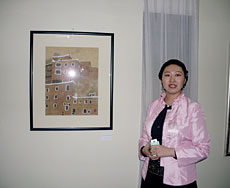It was a rare occasion for art lovers to feast their eyes on the wonderful paintings of Aishah Yun recently on display in Riyadh. Aishah, a Chinese Muslim, has been living in the Kingdom for the past several months. People from all walks of life, including members of the diplomatic corps, found time to see the beautiful paintings of Aishah who had her first exhibition in China in 1997.
Aishah’s exhibition in Riyadh included paintings depicting elements of Chinese, Saudi and Asian cultures. They showed the lives of Chinese Muslims and also featured autumn landscapes. Aishah, who showed an interest in Chinese traditional paintings from childhood, had her early education in Tangshan Hebei Normal School in China and graduated in 1997. As a student, she majored in art and studied Chinese traditional painting, oil painting, water painting and design.
In her first exhibition in 1997, more than 70 paintings were shown. She began her studies at Nanjing Arts Institute of China in 2001 and graduated with a major in sculpture in 2006. During her career, she has received several awards such as “New Artist Award” in Chinese Juvenile Art Competition, “Outstanding Student Scholarship” and “The Best Works Award” in the Chinese Arts Institute Student’s Works. She also worked in Nanjing Brocade Research Institute as a designer and has served as an art teacher in a private high school in Nanjing.
Aishah thanked Sakina Boukhaima-Bonne, who works for the French Embassy and Gulmira Abdukhalikova, a noted pianist, for their cooperation in making her first show in the Kingdom a great success. She said that it had taken nearly nine months to complete all her work, during which period her husband Yun, an IT engineer, and the two friends mentioned above gave her the encouragement and moral support to carry out her task.
“The response I got today will serve as the first stepping-stone on the path to success. It will enable me to hold future shows. Now I know, there are plenty of people here in Riyadh who appreciate my work and I will come out with many such shows, Insha Allah,” Aishah said. She added that she had a two-month-old baby and that she can paint while her husband is at work and the baby is asleep.
She said paintings are among the oldest Chinese artistic expressions. The earliest paintings were not representational but ornamental; they consisted of patterns or designs rather than pictures.
Stone Age pottery was painted with spirals, zigzags, dots or animals. It was only during the Warring States Period (403-221 B.C.) that artists began to represent the world around them.
Painting in the traditional style is known today in Chinese as guó huà, meaning “national” or “native painting”, as opposed to Western styles of art which became popular in China in the 20th century.
Traditional painting involves essentially the same techniques as calligraphy and is done with a brush dipped in black or colored ink; oils are not used.
As with calligraphy, the most popular materials on which paintings are done are paper and silk. The finished work is then mounted on scrolls, which can be hung or rolled up.
Traditional painting also is done in albums and on walls, lacquer work and other media.
There are mainly two techniques in Chinese painting, which are:
Meticulous — Gong-bi — often referred to as “court-style” painting and Freehand — Shui-mo — loosely termed water-color or brush painting. The Chinese character “mo” means ink and “shui” means water. This style is also referred to as “xie yi” or freehand style.


